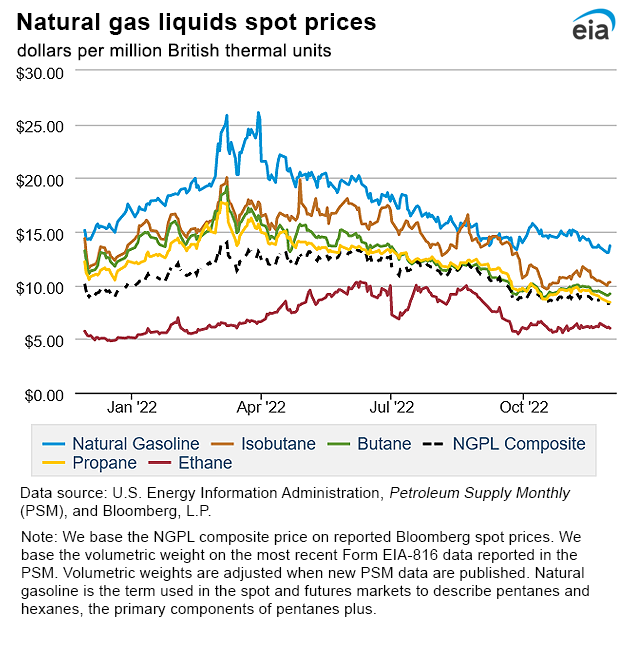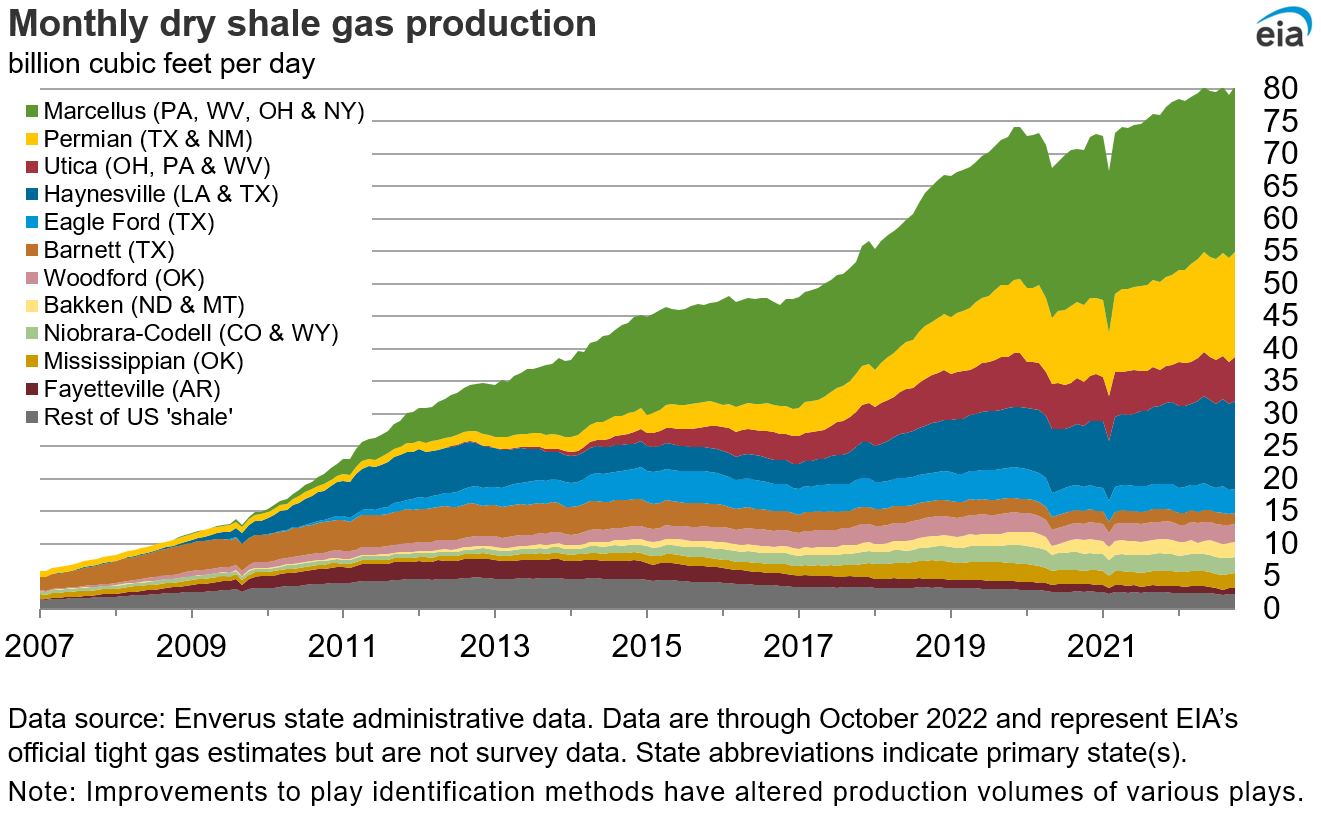In the News:
Europe’s LNG import capacity set to expand by one-third by end of 2024
We estimate that the capacity of liquefied natural gas (LNG) import terminals (called regasification terminals) in the European Union (EU‒27) and the UK will expand by approximately 5.3 billion cubic feet per day (Bcf/d) by the end of next year. This capacity will expand by another 1.5 Bcf/d by the end of 2024, for a total of 6.8 Bcf/d of new LNG regasification capacity added in the region (34% expansion) compared with 2021.
LNG regasification capacity in the EU-27 and the UK remained relatively stable and expanded modestly in the last 10 years, by 2.8 Bcf/d (16%), from 17.5 Bcf/d in 2012 to 20.2 Bcf/d at the end of 2021, according to data from the International Group of Liquefied Natural Gas Importers (GIIGNL). However, since Russia’s invasion of Ukraine in February 2022 and the resulting significant reduction in natural gas pipeline imports from Russia, European countries have reactivated development of previously dormant regasification projects and have started development of new projects.
Many of the new regasification projects in Europe can be developed relatively quickly by chartering Floating Storage and Regasification Units (FSRUs) and building pipelines to transport regasified natural gas to connecting pipelines onshore. Other EU regasification projects involve expanding capacity at existing terminals and implementing upgrades to increase existing terminals’ throughput.
Between January and November 2022, an estimated 1.7 Bcf/d of new and expanded LNG regasification capacity was added in Poland, Italy, the Netherlands, Finland, and Germany. The new EemsEnergy terminal in the Netherlands (0.8 Bcf/d capacity) consists of two FSRU vessels, and received its first import cargo in September 2022. A new FSRU terminal at Wilhelmshaven Port in Germany (0.7 Bcf/d capacity) was completed in November 2022.
By the end of 2023, LNG regasification terminals that are currently under construction in Germany, Poland, France, Finland, Estonia, Italy, and Greece will add 3.5 Bcf/d of new capacity:
- In Germany, three FSRU terminals with a combined regasification capacity of 1.4 Bcf/d are being developed at Lubmin, Brunsbuttel, and Wilhelmshaven. Two terminals (at Lubmin and Brunsbuttel) are expected to start operations this winter, and the second terminal at Wilhelmshaven is expected online in 2023. LNG imports at these terminals are expected to partially replace natural gas imports by pipeline from Russia, which averaged 4.6 Bcf/d from January through July 2022.
- In Poland, the existing LNG regasification terminal at Świnoujście will complete expansion of 0.2 Bcf/d to reach a total capacity of 0.8 Bcf/d.
- In France, the FSRU vessel Cape Anne (capacity 0.4 Bcf/d) at Le Havre port is expected to start operations in the fall of 2023.
- Finland and Estonia are jointly developing an FSRU terminal (capacity 0.5 Bcf/d), which will be located in the Finnish port of Inkoo. The terminal is expected online this winter.
- In Italy, a new FSRU terminal is being developed near Port of Piombino, which will add 0.5 Bcf/d of capacity and will likely come online in spring 2023.
- In Greece, an FSRU vessel (capacity 0.5 Bcf/d) at Alexandroupolis port is expected online by the end of 2023.
Market Highlights:
(For the week ending Wednesday, November 30, 2022)Prices
- Henry Hub spot price: The Henry Hub spot price rose 34 cents from $6.46 per million British thermal units (MMBtu) last Wednesday to $6.80/MMBtu yesterday.
- Henry Hub futures prices: The December 2022 NYMEX contract expired Monday at $6.712/MMBtu, down 60 cents from last Wednesday. The January 2023 NYMEX contract price decreased to $6.930/MMBtu, down 78 cents from last Wednesday to yesterday. The price of the 12-month strip averaging January 2023 through December 2023 futures contracts declined 15 cents to $5.709/MMBtu.
- Select regional spot prices: Natural gas spot prices rose at most locations this report week (Wednesday, November 23, to Wednesday, November 30). Week-over-week price changes at major pricing hubs ranged from an increase of $8.72 at SoCal Citygate in Southern California to a decrease of $0.38 at Cheyenne Hub in the Rocky Mountain region.
- Prices across much of the West rose significantly this week. Prices at Opal in Southwest Wyoming, the main trading point for natural gas in the Rocky Mountain region and the origin point for deliveries into the California market through the Ruby Pipeline, rose $6.06 from $10.00/MMBtu last Wednesday to $16.06/MMBtu yesterday. At Northwest Sumas, located in Washington on the border with Canada and the primary natural gas trading hub for consumers in the Pacific Northwest (Washington, Oregon, and Idaho), the price rose $4.61 from $11.85/MMBtu last Wednesday to $16.46/MMBtu yesterday. Prices at the Malin hub on the Oregon/California border, the main northern delivery point into the PG&E service territory, rose $5.10 from $12.00/MMBtu last Wednesday to $17.10/MMBtu yesterday, its highest daily price since February 2019. Several factors contributed to the rapid price increases this report week, including colder temperatures in western Canada that led to a 0.2 billion cubic feet per day (Bcf/d) decrease in exports to the Western region this report week, according to data from PointLogic. At the Westcoast Station 2 pricing point in central British Columbia, Canada, the main aggregation point for natural gas produced in northeast British Columbia and western Alberta before these volumes are shipped south along the Enbridge Westcoast Energy pipeline, prices rose $4.96/MMBtu, from $1.58/MMBtu last Wednesday to $6.54/MMBtu yesterday. Overall natural gas consumption in the residential and commercial sectors combined increased by 2% (0.1 Bcf/d) week over week in the Western region. In the Seattle City Area, temperatures averaged 40°F this report week, leading to 175 heating degree days (HDD), 29 more HDDs than last week. Last Thursday, daily temperatures in the Seattle City Area averaged 43°F. They fell to a daily average of 35°F on Monday, while yesterday they averaged 37°F.
- In California, the price at PG&E Citygate in Northern California rose $4.55, up from $12.25/MMBtu last Wednesday to $16.80/MMBtu yesterday. The price at SoCal Citygate in Southern California increased $8.72 from $10.57/MMBtu last Wednesday to $19.29/MMBtu yesterday. California prices rose as a result of higher prices across the West, and they have also been affected by pipeline constraints on westbound flows from the Permian Basin. El Paso Natural Gas Company planned electrical unit maintenance at the Waha station Monday through Friday of this week, reducing westbound flows by up to 138 million cubic feet per day.
- In the Northeast, prices rose this report week. At the Algonquin Citygate, which serves Boston-area consumers, the price rose $3.11 from $6.80/MMBtu last Wednesday to $9.91/MMBtu yesterday. At the Transcontinental Pipeline Zone 6 trading point for New York City, the price increased 63 cents from $6.10/MMBtu last Wednesday to $6.73/MMBtu yesterday. Prices in the Northeast have fluctuated in recent weeks, with the price at Algonquin Citygate falling to a monthly low of $0.74/MMBtu on November 4 and rising as high as $11.60/MMBtu on November 18. Daily natural gas consumption has fluctuated across the week with temperatures. In the Boston Area, temperatures rose from the start of the report week to a daily average of 50°F on Sunday. Temperatures subsequently fell to a daily average of 38°F on Tuesday, before rising to a daily average of 49°F yesterday. The price at Algonquin Citygate set a weekly low of $5.86/MMBtu on Monday.
- International futures prices: International natural gas futures prices increased this report week. According to Bloomberg Finance, L.P., weekly average futures prices for liquefied natural gas (LNG) cargoes in East Asia increased $2.95 to a weekly average of $31.01/MMBtu, and natural gas futures for delivery at the Title Transfer Facility (TTF) in the Netherlands, the most liquid natural gas market in Europe, increased $4.07 to a weekly average of $40.01/MMBtu.
- Natural gas plant liquids (NGPL) prices: The natural gas plant liquids composite price at Mont Belvieu, Texas, fell by 36 cents/MMBtu, averaging $8.30/MMBtu for the week ending November 30. Ethane fell 2%, while natural gas prices at the Houston Ship Channel rose 3%, narrowing the ethane premium to natural gas by 33%. Ethylene spot prices fell 1%, widening the ethylene to ethane premium by 3%. Propane prices fell 7%, while the weekly average price of Brent crude oil fell 3%, resulting in a 2% increase in the propane discount relative to crude oil. Normal butane, isobutane, and natural gasoline prices followed crude oil prices, with both butanes falling by 4% and natural gasoline falling by 3%.
Daily spot prices by region are available on the EIA website.
Supply and Demand
- Supply: According to data from PointLogic, the average total supply of natural gas fell by 0.6% (0.7 Bcf/d) compared with the previous week. Dry natural gas production grew by 0.5% (0.5 Bcf/d), and average net imports from Canada decreased by 18.4% (1.2 Bcf/d) from last week.
- Demand: Total U.S. consumption of natural gas fell by 16.5% (16.6 Bcf/d) compared with the previous week, according to data from PointLogic. Natural gas consumed for power generation declined by 14.4% (4.7 Bcf/d) week over week. Industrial sector consumption decreased by 5.1% (1.3 Bcf/d) week over week, and residential and commercial sector consumption declined by 25.1% (10.6 Bcf/d) as warmer-than-normal weather stretched from the Midwest to the east coast. Natural gas exports to Mexico increased 5.8% (0.3 Bcf/d). Natural gas deliveries to U.S. LNG export facilities (LNG pipeline receipts) averaged 11.6 Bcf/d, or 0.5 Bcf/d lower than last week.
Liquefied Natural Gas (LNG)
- Pipeline receipts: Overall natural gas deliveries to U.S. LNG export terminals decreased by 0.5 Bcf/d week over week to average 11.6 Bcf/d this report week, according to data from PointLogic. Natural gas deliveries to LNG export terminals in South Louisiana fell by 0.1 Bcf/d to 8.5 Bcf/d, while deliveries to LNG export terminals in South Texas fell by 0.4 Bcf/d.
- Vessels departing U.S. ports: Sixteen LNG vessels (seven from Sabine Pass, three each from Cameron and Corpus Christi, two from Calcasieu Pass, and one from Elba Island) with a combined LNG-carrying capacity of 59 Bcf departed the United States between November 24 and November 30, according to shipping data provided by Bloomberg Finance, L.P.
Rig Count
- According to Baker Hughes, for the week ending Tuesday, November 23, the natural gas rig count decreased by 2 rigs from a week ago to 155 rigs. The Haynesville and an unidentified producing region each dropped one rig. The number of oil-directed rigs increased by 4 rigs from a week ago to 627 rigs. The Permian added three rigs, the Cana Woodford added one rig, and two rigs were added in unidentified producing regions. The Arkoma Woodford and the Barnett each dropped one rig. The total rig count, which includes 2 miscellaneous rigs, now stands at 784 rigs, the highest level since March 13, 2020, and 215 more rigs than the same week last year.
Storage
- The net withdrawals from storage totaled 81 Bcf for the week ending November 25, compared with the five-year (2017–2021) average net withdrawals of 34 Bcf and last year's net withdrawals of 54 Bcf during the same week. Working natural gas stocks totaled 3,483 Bcf, which is 86 Bcf (2%) lower than the five-year average and 89 Bcf (2%) lower than last year at this time.
- According to The Desk survey of natural gas analysts, estimates of the weekly net change to working natural gas stocks ranged from net withdrawals of 76 Bcf to 121 Bcf, with a median estimate of 86 Bcf.
See also:
Top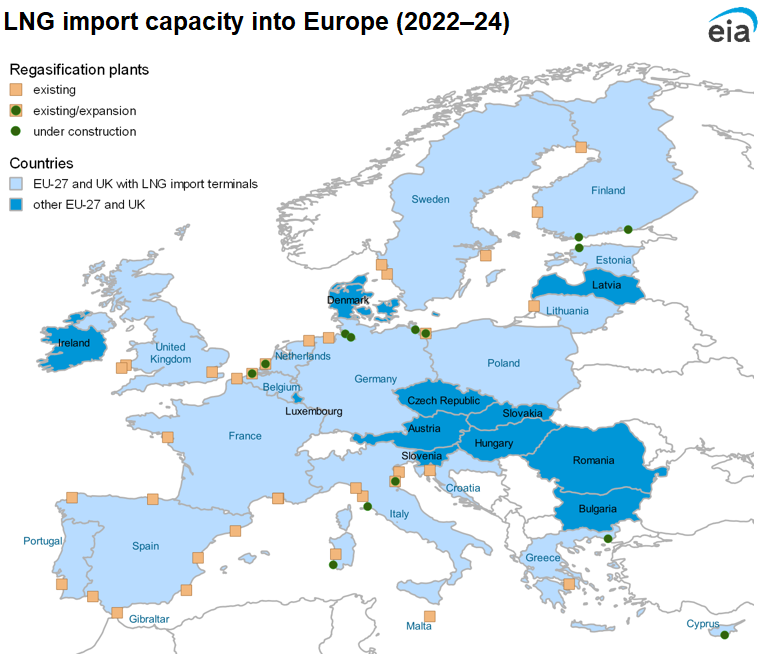
Data source: The International Group of Liquefied Natural Gas Importers (GIIGNL) and trade press
Note: Map displays existing and under construction LNG import terminals in the European Union and UK as of November 2022. LNG import terminals under construction are expected to come online in 2022–24. LNG = liquefied natural gas.
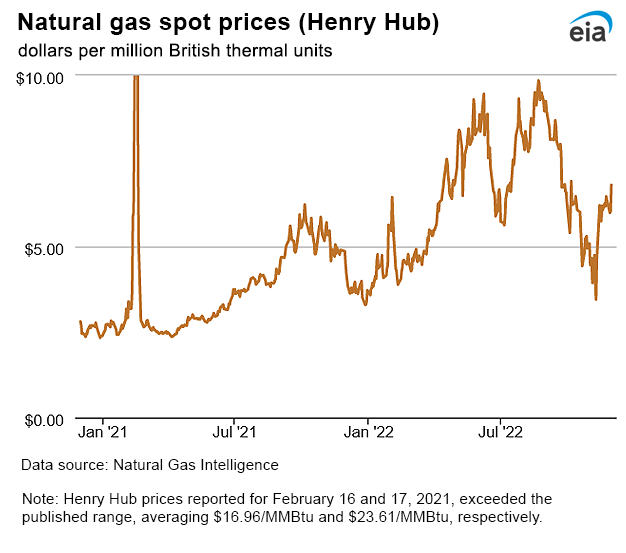
| Spot Prices ($/MMBtu) | Thu, 24-Nov |
Fri, 25-Nov |
Mon, 28-Nov |
Tue, 29-Nov |
Wed, 30-Nov |
|---|---|---|---|---|---|
| Henry Hub | Holiday | Holiday | 5.99 | 6.03 | 6.80 |
| New York | Holiday | Holiday | 5.45 | 6.27 | 6.73 |
| Chicago | Holiday | Holiday | 5.48 | 6.50 | 5.92 |
| Cal. Comp. Avg.* | Holiday | Holiday | 12.09 | 14.87 | 17.02 |
| Futures ($/MMBtu) | |||||
| December Contract | Holiday | 7.024 | 6.712 | Expired | Expired |
| January Contract | Holiday | 7.330 | 7.196 | 7.235 | 6.930 |
| February Contract | Holiday | 7.135 | 7.018 | 7.084 | 6.818 |
| Data source: Natural Gas Intelligence and CME Group as compiled by Bloomberg, L.P. *Avg. of NGI's reported prices for: Malin, PG&E Citygate, and Southern California Border Avg. |
|||||
| Spot Prices ($/MMBtu) | Thu, 17-Nov |
Fri, 18-Nov |
Mon, 21-Nov |
Tue, 22-Nov |
Wed, 23-Nov |
|---|---|---|---|---|---|
| Henry Hub | 6.19 | 6.07 | 6.26 | 6.18 | 6.46 |
| New York | 7.27 | 8.14 | 6.97 | 6.00 | 6.10 |
| Chicago | 6.29 | 5.99 | 6.18 | 5.81 | 6.21 |
| Cal. Comp. Avg.* | 8.41 | 8.33 | 9.27 | 10.23 | 11.40 |
| Futures ($/MMBtu) | |||||
| December Contract | 6.369 | 6.303 | 6.776 | 6.779 | 7.308 |
| January Contract | 6.744 | 6.716 | 7.223 | 7.406 | 7.708 |
| Data source: Natural Gas Intelligence and CME Group as compiled by Bloomberg, L.P. *Avg. of NGI's reported prices for: Malin, PG&E Citygate, and Southern California Border Avg. |
|||||
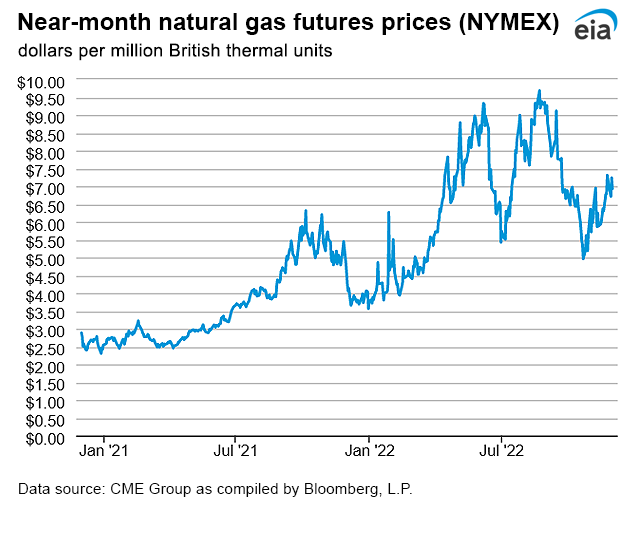
| U.S. natural gas supply - Gas Week: (11/24/22 - 11/30/22) | |||
|---|---|---|---|
Average daily values (billion cubic feet) |
|||
this week |
last week |
last year |
|
| Marketed production | 113.7 |
113.1 |
109.1 |
| Dry production | 101.2 |
100.7 |
97.9 |
| Net Canada imports | 5.1 |
6.3 |
5.5 |
| LNG pipeline deliveries | 0.1 |
0.1 |
0.1 |
| Total supply | 106.4 |
107.0 |
103.4 |
|
Data source: PointLogic | |||
| U.S. natural gas consumption - Gas Week: (11/24/22 - 11/30/22) | |||
|---|---|---|---|
Average daily values (billion cubic feet) |
|||
this week |
last week |
last year |
|
| U.S. consumption | 84.0 |
100.6 |
86.3 |
| Power | 28.2 |
32.9 |
28.5 |
| Industrial | 24.2 |
25.5 |
24.7 |
| Residential/commercial | 31.6 |
42.2 |
33.1 |
| Mexico exports | 5.8 |
5.5 |
5.4 |
| Pipeline fuel use/losses | 7.2 |
7.7 |
7.1 |
| LNG pipeline receipts | 11.6 |
12.0 |
12.0 |
| Total demand | 108.6 |
125.9 |
110.9 |
|
Data source: PointLogic | |||
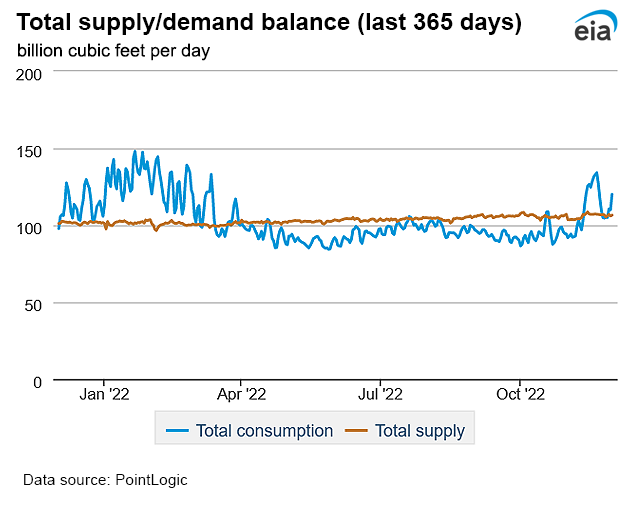
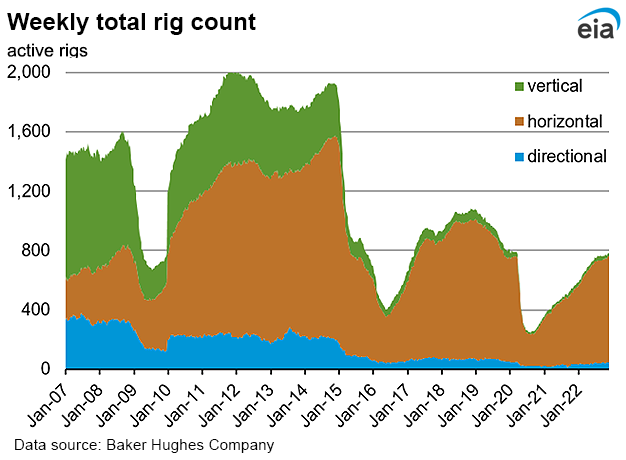
| Rigs | |||
|---|---|---|---|
Tue, November 22, 2022 |
Change from |
||
last week |
last year |
||
| Oil rigs | 627 |
0.6% |
34.3% |
| Natural gas rigs | 155 |
-1.3% |
52.0% |
| Note: Excludes any miscellaneous rigs | |||
| Rig numbers by type | |||
|---|---|---|---|
Tue, November 22, 2022 |
Change from |
||
last week |
last year |
||
| Vertical | 23 |
0.0% |
4.5% |
| Horizontal | 714 |
0.0% |
39.2% |
| Directional | 47 |
4.4% |
38.2% |
| Data source: Baker Hughes Company | |||
| Working gas in underground storage | ||||
|---|---|---|---|---|
Stocks billion cubic feet (Bcf) |
||||
| Region | 2022-11-25 |
2022-11-18 |
change |
|
| East | 840 |
866 |
-26 |
|
| Midwest | 1,040 |
1,063 |
-23 |
|
| Mountain | 197 |
203 |
-6 |
|
| Pacific | 226 |
232 |
-6 |
|
| South Central | 1,181 |
1,200 |
-19 |
|
| Total | 3,483 |
3,564 |
-81 |
|
| Data source: U.S. Energy Information Administration Form EIA-912, Weekly Underground Natural Gas Storage Report | ||||
| Working gas in underground storage | |||||
|---|---|---|---|---|---|
Historical comparisons |
|||||
Year ago (11/25/21) |
5-year average (2017-2021) |
||||
| Region | Stocks (Bcf) |
% change |
Stocks (Bcf) |
% change |
|
| East | 870 |
-3.4 |
868 |
-3.2 |
|
| Midwest | 1,046 |
-0.6 |
1,043 |
-0.3 |
|
| Mountain | 207 |
-4.8 |
208 |
-5.3 |
|
| Pacific | 263 |
-14.1 |
288 |
-21.5 |
|
| South Central | 1,187 |
-0.5 |
1,161 |
1.7 |
|
| Total | 3,572 |
-2.5 |
3,569 |
-2.4 |
|
| Data source: U.S. Energy Information Administration Form EIA-912, Weekly Underground Natural Gas Storage Report | |||||
| Temperature – heating & cooling degree days (week ending Nov 24) | ||||||||
|---|---|---|---|---|---|---|---|---|
HDDs |
CDDs |
|||||||
| Region | Current total |
Deviation from normal |
Deviation from last year |
Current total |
Deviation from normal |
Deviation from last year |
||
| New England | 216 |
40 |
44 |
0 |
0 |
0 |
||
| Middle Atlantic | 209 |
42 |
38 |
0 |
0 |
0 |
||
| E N Central | 235 |
43 |
32 |
0 |
0 |
0 |
||
| W N Central | 244 |
28 |
49 |
0 |
0 |
0 |
||
| South Atlantic | 154 |
41 |
25 |
8 |
-3 |
-2 |
||
| E S Central | 171 |
54 |
36 |
0 |
-1 |
0 |
||
| W S Central | 136 |
54 |
71 |
0 |
-5 |
-5 |
||
| Mountain | 221 |
33 |
65 |
0 |
0 |
-2 |
||
| Pacific | 92 |
-3 |
20 |
0 |
-1 |
0 |
||
| United States | 185 |
34 |
38 |
2 |
-1 |
-1 |
||
|
Data source: National Oceanic and Atmospheric Administration Note: HDDs=heating degree days; CDDs=cooling degree days | ||||||||
Average temperature (°F)
7-day mean ending Nov 24, 2022
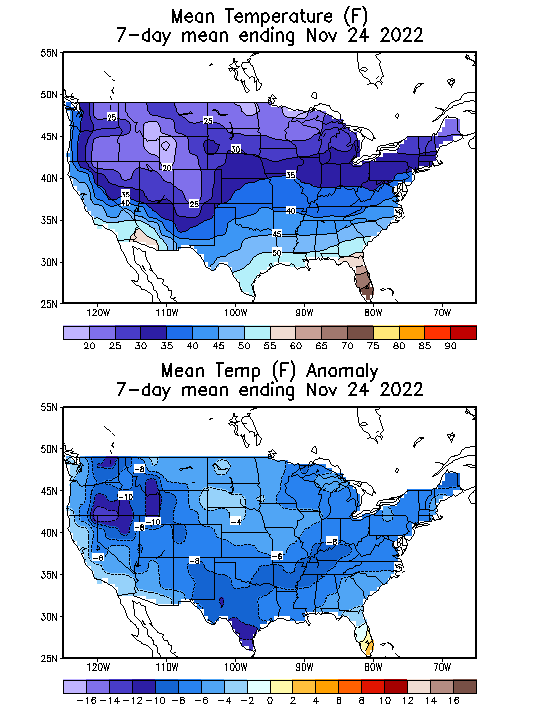
Data source: National Oceanic and Atmospheric Administration
Deviation between average and normal temperature (°F)
7-day mean ending Nov 24, 2022

Data source: National Oceanic and Atmospheric Administration

